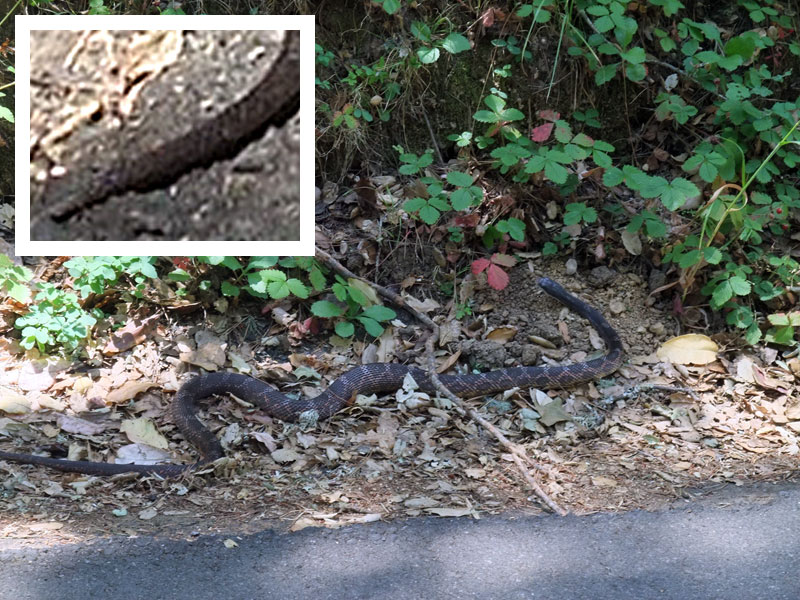

The original plan went to pieces when Kevin developed quite a nasty headache prior to the ride (a “cluster” headache I’m told it’s called), but, somewhat against his wishes, I did get him out on the road. He was giving me the silent treatment until we got about a third of the way up Old LaHonda when he yells to me, “Did you see the snake?” No, I hadn’t seen it, but he circled back to show me where it was (although between the time he’d seen it and then went back to find it, the snake had literally holed itself up in a hole in the embankment, but eventually came back out to find out what was going on).
This guy was pretty big, and pretty mobile. The warm weather gets them moving faster, but also a bit more aggressive, so that, once settled into the drainage area along the side of the road, he lifted his head up about a foot or so, definitely trying to strike a threatening pose. Normally, I remove snakes from the roadway so they don’t get run over, but thankfully this guy wasn’t in the road (close though) and besides, I’m not going to play around much with what might be a good-sized rattlesnake. So instead we stayed around for a bit, warning anyone riding up the hill to stay to the other side of the road (since this guy was easily within striking distance of an uphill cyclists’ legs). Check this out for a prior ride where we came across a no-question-about-it rattlesnake.
 Eventually we moved on, heading over the top of Old LaHonda and down the other side to San Gregorio. The original plan had been to head to Pescadero and return via West Alpine, but that wasn’t going to happen, not with Kevin still feeling a bit under the weather, so instead we went north to Los Lobitos, took in that nasty steep section and then looped back to Tunitas.
Eventually we moved on, heading over the top of Old LaHonda and down the other side to San Gregorio. The original plan had been to head to Pescadero and return via West Alpine, but that wasn’t going to happen, not with Kevin still feeling a bit under the weather, so instead we went north to Los Lobitos, took in that nasty steep section and then looped back to Tunitas.
Only 47 miles with about 5100ft of climbing, but still a nice ride, and enough to keep my weight about two pounds below where it was last year.






Looks like a diamondback from the pattern on its back, but the head looks more gopher-snake-like. Hard to tell from your photo. If it’s triangular-shaped, it’s a rattler. Gopher snakes have sleeker heads and the skin pattern is more circular with more whitespace. But gopher snakes can act aggressively and shake their tails in dry leaves to imitate rattlers if provoked.
Good for you for trying to get them off the road. But use a stick if you can. Young rattlers can be especially dangerous to handle. Unlike adults they haven’t learned to strike defensively while withholding their venom and saving it for prey.
Bill: Had someone just in the shop who’s got quite a bit of experience with snakes (special forces guy). Says the head looks more like a gopher snake and that he has seen gopher snakes not only strike an aggressive stance but also attack people. Obviously not the gopher snakes that used to hang out in my parent’s back yard when I was growing up!
Anytime you see me stopped on west Old LaHonda or Lobitos or the base of Tunitas on a hot day, it’s usually to move a snake off the road. Sadly, most are already dead, typically with pinch marks due to having been dropped by a bird. Still, I’m likely to find one live one a month, sometimes more often, in need of encouragment to make it to the other side. The tough ones are the smaller rattlesnakes, since they’re more active and want to strike at anything. The big guys could care less unless you surprise them.
Looking at the head shot close-up, I’m pretty sure it’s a gopher snake, not a rattler. Very young rattlers may not have visible rattles, but this one is too mature not to have visible rattles, and I can’t see any in your close-up tail photo.